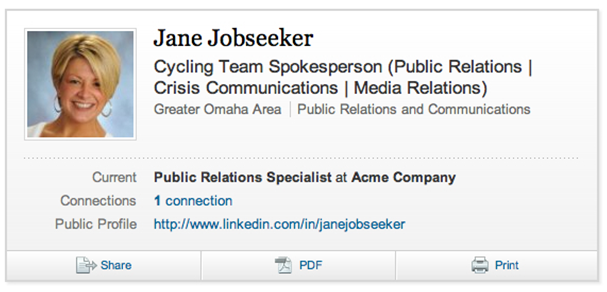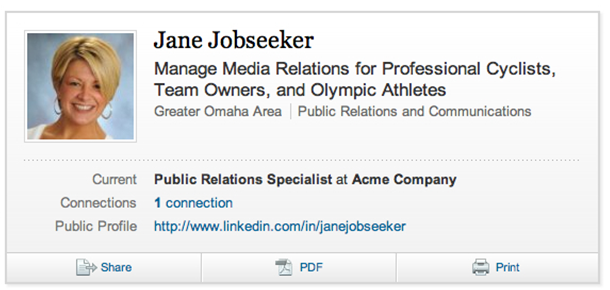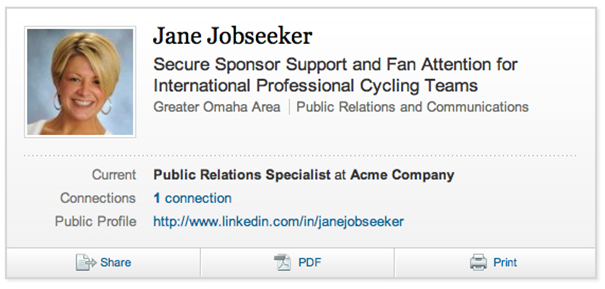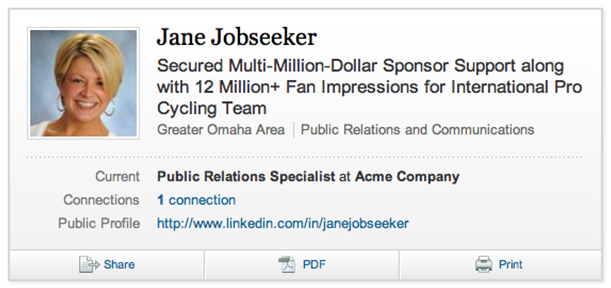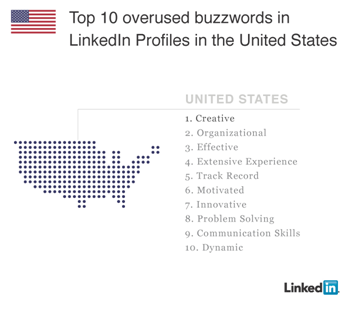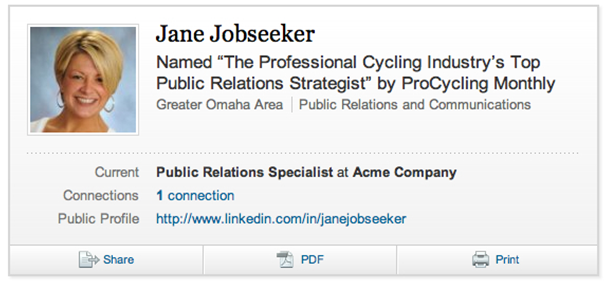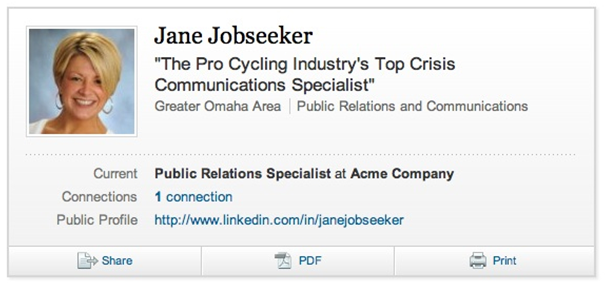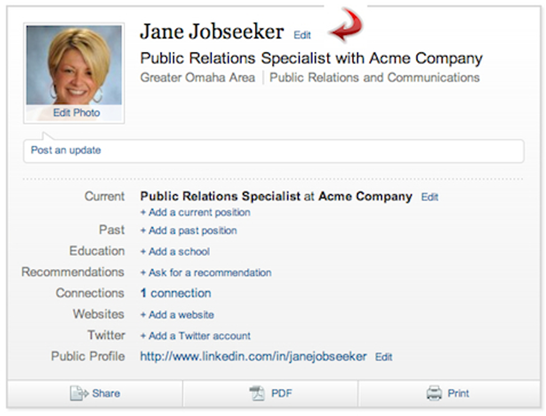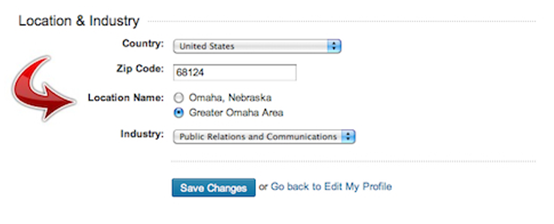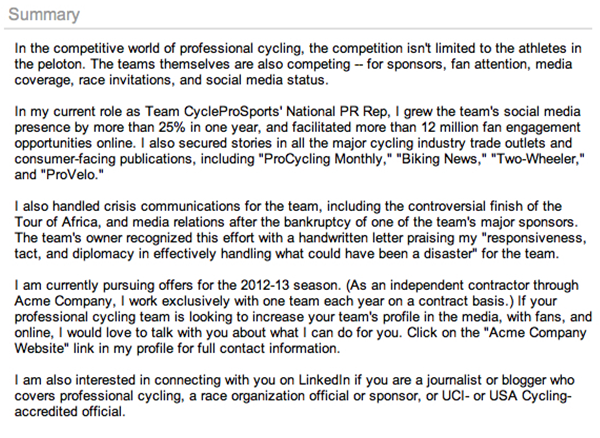Having an online presence on LinkedIn can be important in your job search. Your LinkedIn profile can present your credentials to prospective employers and hiring managers, increasing your chance of securing an interview.
Your LinkedIn profile should complement your résumé, but it shouldn’t duplicate it directly. To have a strong online presence, you must be clear about who you are, and who you are not. (An unfocused LinkedIn profile may be worse than no profile at all.) Your LinkedIn profile can also be more comprehensive than your résumé, since it offers you more room to showcase projects, publications, and experience.
A successful LinkedIn profile gives readers a snapshot of who you are and how you can contribute to their organization. You must understand and be able to articulate and communicate what makes you exceptional and compelling.
The purpose of this report is to help you develop a LinkedIn profile that will lead to job opportunities, contacts from prospective employers and recruiters, and increased visibility online. All of these will help in your job search.
One of the most effective ways to establish a presence online (so that you are found when someone “Googles” you), is with a LinkedIn profile. You want an online profile that you control, that you can take with you — independent of any employer — and that demonstrates what kind of job candidate you are (and what you do). Best of all, LinkedIn’s basic features are free.
Your LinkedIn profile is a marketing piece — not a biography or a résumé. It’s not designed to outline your entire professional history. Instead, it provides enough information to get people to connect with you — and/or make a contact with you. Because it’s a marketing piece, you need to come up with a headline that will instantly attract the attention of your reader. You have approximately 20 seconds to catch the attention of a visitor to your profile. Consequently, you must find a way to stand out in a crowd. If your profile is like every other profile on LinkedIn, you won’t stand out, and you won’t be found as easily.
Standing out with your LinkedIn profile can mean highlighting the strongest qualifications you have for an employer in your LinkedIn headline, backing up those qualifications with accomplishments throughout your profile summary, and using strategies that will help you become found by the people who most need someone like you.
“Don’t try to be all things to all people.” Although you can create different targeted versions of your résumé to target different types of positions, you’re limited to one LinkedIn profile. On LinkedIn — as on your résumé — one size does not fit all.
The most difficult part of creating your LinkedIn profile is sounding original. By articulating what makes you unique and valuable, you will attract attention from prospective employers. Be specific about what distinguishes you from others with a similar job title.
The answers to these questions may give you some ideas for creating your LinkedIn profile and headline:
- What specific job titles are used to describe someone in your position? (Be specific regarding level, functional role, and industry.)
- In performance reviews, in what areas do you receive the highest scores or the most positive feedback?
- What is the most important part of your current job?
- What is your biggest achievement in your job — have you saved your company money, helped the company make money, or helped it become more efficient, improve safety, improve customer service, etc.
- What are your top three skills?
- What are you best known for at work?
- If you were asked to select your replacement, what qualities would you be looking for?
- What kind of challenges at work do you most enjoy working on?
- Do you have any specific training or credentials that distinguish you?
- What makes you different from other (job titles)? Is there an area where you are better than others?
- Can you distinguish yourself by the geographic area you work in or your years of experience?
When someone searches for you on LinkedIn, they will see three things: Your name, your LinkedIn headline, and your location. In many cases, hiring managers and recruiters will make the decision to read your full LinkedIn profile based on just these three things. Consequently, the LinkedIn headline acts like a newspaper or magazine title. It gives the reader an idea of what your profile will include (just like a newspaper headline previews a story). Being specific results in a much better headline. Great headlines attract attention, and the more people who view your LinkedIn profile, the better your chances of connecting with the right person who can lead you to your dream job.
Your headline needs to quickly identify you as a certain type of person — i.e., manager or executive, or someone who specializes in a certain field or industry.
A well-written headline will also help you to structure the rest of the information you include in your LinkedIn profile. If the information doesn’t support the headline, consider whether it should be included at all. Remember, focus is important.
Note: LinkedIn’s default for your headline is your job title and company. If you don’t change it, this is what LinkedIn will show on your profile.
The Role of Keywords In Your LinkedIn Profile
Keywords also play an important part for you in being found by people who don’t know you on LinkedIn — this is particularly true for jobseekers who are hoping for contacts from prospective employers and recruiters. Keywords are a list of words and phrases that are related to your work — they are the words that a prospective employer would search for when trying to find someone like you. LinkedIn headlines are searchable fields using the “People Search” function when someone is looking for particular skills, interests, qualifications, or credentials.
You can also incorporate keywords throughout your LinkedIn profile, including:
- Your LinkedIn profile headline
- Current and former work experience
- LinkedIn summary section
- Specialties or Skills section
Where can you find keywords? Brainstorm them. Write down a list of words that relates to you, your work, your industry, and your accomplishments. Try to come up with as big of a list as you can; you will narrow it down later.
You can also find keywords in job postings or job descriptions. Check out online job boards for positions (don’t worry about where the job is located, just find positions that are similar to the one you’re seeking and write down the keywords.)
You can also find broad job descriptions — with plenty of keywords — in the U.S. Department of Labor’s free Occupational Outlook Handbook (http://www.bls.gov/ooh/).
Another great research tool is Google’s Adwords Keywords Tool, which can be found at: https://adwords.google.com/select/keywordToolExternal. You can use keywords you identified through your earlier research and it will suggest related keywords (it will also tell you the popularity of the keywords you enter as they relate to current Google search results).
Now it’s time to narrow down your keywords and pick a “Top 10” that you will use in your LinkedIn headline and profile.
The keywords that you select for your profile must fit two criteria:
- They must speak to your “onlyness” — that is, what you want to be known for.
- They must align with what employers value — that is, what they want.
Focusing on these areas enables you to get the most out of your online efforts while differentiating you from other job candidates with the same job title. You need to express clearly: “I am this.” Someone who is reading your LinkedIn profile should be able to recognize you in it. If what you wrote could apply to anyone with your job description, revise what you’ve written.
How to Write an Attention-Getting LinkedIn Headline
The headline and the first 2-3 sentences of your LinkedIn profile summary are critical to making connection and securing opportunities from recruiters and hiring managers.
You can learn a lot about developing your profile from online dating sites — because the concept is the same. You have to get someone’s attention. Your profile may be the first impression that hiring managers have of you — so make it count! You’re trying to get them to take a first step and reach out to connect with you.
Focus on what you have to offer a prospective employer; don’t focus on you. The information you provide should be 80 percent about what you have done for your current employer (accomplishments-oriented), and 20 percent about you and what you’re looking for. Unfortunately, most LinkedIn profiles (especially the summary section!), are the reverse.
Think of it this way: Prospective employers are tuned into a particular radio station — it’s called “WIIFM.” All employers are listening for is: “What’s In It For Me?” (WIIFM). Remember: Employers hire for their reasons, not yours.
What proof do you have that you can offer the employer the results they are seeking? Quantify your accomplishments as much as possible in terms of numbers, percentages, and dollar amounts.
Don’t copy someone else’s LinkedIn profile. Be original! Look at other profiles for ideas, but don’t copy someone else’s headline or summary. Remember — your online presence must speak to your “onlyness.” Also, give your profile some personality!
People who make a connection with you through your profile are more likely to contact you about a career opportunity.
Formula for Writing an Effective LinkedIn Headline
There are generally two schools of thought when it comes to writing your profile headline. The first is using a narrative or descriptive title; the second is simply using keywords separated by commas, bullets, or the pipe symbol on your keyboard ( | ).
LinkedIn’s current algorithm gives higher ranking to matching keywords, so strategy number two appeals more to computer searches, while strategy number one appeals to human readers. Eventually, all profiles found through computer searches will be reviewed by a human being, however, so it is important to balance readability with the inclusion of keywords.
You are limited to just 120 characters in your LinkedIn headline, so it’s also important to be succinct and direct.
Things you can consider including in your LinkedIn headline:
- Job titles
- Types of customers / projects you work with
- Industry specialization
- Brands you’ve worked for
- Certifications or designations
- Geographic territory specialization
Note: If you don’t write your own headline, LinkedIn will create one for you — usually, the most recent job title in your profile and a company or organization name. This is very similar to strategy number one, so this is the most common type of LinkedIn profile you will see on the site.
To improve readability, capitalize the first letter of each of the words in your headline.
Here are some strategies for writing your LinkedIn headline, along with the advantages and disadvantages that go along with each tactic.
- Keep It Simple. Say it simply and directly: Your job title and the company you work for. This is a good strategy if your job title is a strong keyword and/or the company you work for is well-known. The advantage is that it clearly communicates who you are and what you do; the disadvantage is that it doesn’t set you apart from many others who could claim those same credentials.
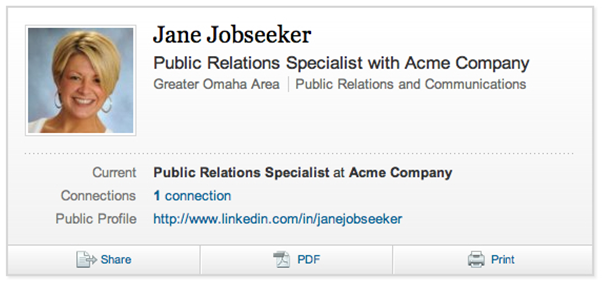
This strategy can also use the following formulas:
- (Job Title)
- (Job Title) at (Company Name)
- (Job Title) for (Industry) at (Company Name)
- (Job Title) Specializing in (Keywords)
For example, here is an example of a headline that incorporates a job title and keywords:
- What You Do. This strategy focuses on job functions instead of job titles. The advantage to this headline strategy is that job functions often make excellent keywords. The possible problem is if you simply string together a bunch of job functions without creating a story to explain who you are — along with what you do — so make sure you add some context to your keywords/job functions.
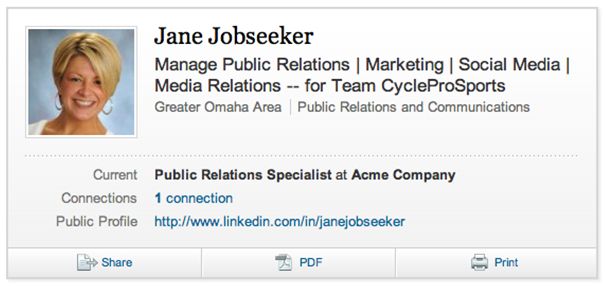
This strategy can also incorporate key projects and/or the names of key clients or important employers, especially if any of those have high “name recognition” value. You may also wish to include a specific industry or geographic area to your job function-focused headline.
Here is an example that uses job function and targets the kinds of clients this consultant serves:
- The Big Benefit. It’s important to identify the primary benefit you have to offer a prospective employer. Target what author Susan Britton Whitcomb says are “Employer Buying Motivators” in her book Résumé Magic. The 12 specific needs a company has include the company’s desire to: make money, save money, save time, make work easier, solve a specific problem, be more competitive, build relationships or an image, expand their business, attract new customers, and/or retain existing customers.
How can you be a problem solver for your next employer? Think about the job you want and what your next boss would want in an employee in that role. Make that the focus of your headline.
This can be expressed in several different ways:
- (Job Title) That Gets (Results)
- (Adjective) (Job Title) With a Track Record of Success in (Results)
Be specific! Adding numbers and other specific wording can make your LinkedIn headline much more powerful. Here is the same strategy, but this one quantifies the scope and scale of the benefit to the employer:
But try not to include the “Top 10 Overused Buzzwords in LinkedIn Profiles in the United States.” Here is the 2011 list:
- An Enthusiastic Testimonial. This headline strategy works best when you’ve received honors or recognition within your field. This can be an extremely effective strategy if you word it correctly. It’s important that the designation is clear enough to stand on its own without too much detail. It if requires too much explanation, you may not have enough room within LinkedIn’s 120-character limit. A word of caution, however: Don’t trade on honors or recognition that are too far in the past. “Four-Time President’s Award-Winner for Revenue Growth in the Ball Bearings Industry” isn’t as impressive if those awards were for 1998, 2001, 2003, and 2005.
This strategy also works if you can make a claim that is defensible (if the statement is “arguably true”). Put the claim in quotes so it appears as if it was published somewhere.
If you are having trouble writing your LinkedIn headline, write a very rough draft. It doesn’t matter if it’s not good, or if you have to leave some blanks. Having a framework will make it easier for you to complete later. Go ahead and finish writing the rest of your LinkedIn profile and then come back to it. Oftentimes, the headline will become much clearer at that point. (Just remember to review your LinkedIn profile to make sure all the information you’ve included supports the focus of the content, as directed by the headline and summary.)
You can also look on LinkedIn for inspiration. Check out the headlines and summaries of people you’re connected with, or do a search for others in your field. Just remember not to copy their information; instead, use it as inspiration.
How to Change Your LinkedIn Headline
Sign into your LinkedIn account. From the main menu, choose “Edit Profile” under the “Profile” tab.
On the “Edit Profile” page, click next to the “Edit” button next to your name.
You will be taken to a “Basic Information” page where you can type your headline into a text box labeled “Professional ‘Headline.’”
 There’s one more thing you should consider on the “Basic Information” page. Remember, LinkedIn will display your name, headline, and location on its search results page. You can adjust what information LinkedIn shows in the results using the “Location & Industry” section. Be sure to click “Save Changes” before leaving the page.
There’s one more thing you should consider on the “Basic Information” page. Remember, LinkedIn will display your name, headline, and location on its search results page. You can adjust what information LinkedIn shows in the results using the “Location & Industry” section. Be sure to click “Save Changes” before leaving the page.
The “Summary” section of your LinkedIn profile is a vital part of your LinkedIn presence. You have 2,000 characters to give readers a brief snapshot of who you are.
The first 2-3 sentences need to instantly get your prospects interested in your profile — or, even better, get them excited about reading the rest of your profile. How do you add more value to the company, or solve problems better than other job candidates? Your LinkedIn summary can set you apart from other jobseekers on LinkedIn by demonstrating that you understand what employers want — and what you have to offer that meets that need.
Address these questions:
- How will your next employer benefit by hiring you? Quantify the value in terms of numbers, money, and/or percentages. Use specific numbers and facts to build credibility.
- What experience can you offer that will provide value to your next employer?
- What additional skills do you have that set you apart from other candidates with a similar background?
Write naturally and conversationally. In contrast to your résumé, you should use pronouns in your summary. Speak in the first person, not third person. (“I did such-and-such.”) Write as if you’re speaking to an individual reader. Make it personal. Be sure to emphasize outcomes — as well as what makes you uniquely qualified to do the job you do. Try to find a common THREAD through your work. Then, once you have a theme, use storytelling principles to write your summary as a narrative. Have a beginning, a middle, and an end.
Your summary can be anywhere from a few sentences up to a few paragraphs. But don’t waste any words — make the most dramatic, powerful, attention-getting statement you can. Don’t use any more words than is necessary, and don’t be overly flowery in your language. The point of the first sentence is to get the prospect to read the second sentence. And the next sentence. And the next.
Be conversational and informal in your tone. Use contractions (“you’re” instead of “you are”). Every word counts! And pay attention to grammar and spelling. Make sure there are no mistakes in your profile. Re-read and edit it. Have a colleague, friend, or spouse read it. Copy-and-paste it into a word processing program and run a spell-check on it.
You can also use asterisks, dashes, hyphens, and other keyboard characters to format the summary and make it easier to read.
Here is Jane Jobseeker’s profile summary:
Notice the format:
- In the opening paragraph, draw attention to issues, challenges, or problems faced by your prospective employer.
- In the second and third paragraphs, demonstrate the value you offer to employers by quantifying the accomplishments in your current position (ideally related to the problems outlined in the first paragraph).
- In the fourth paragraph, talk about why you might be open to inquiries (if you are a passive candidate). If you are unemployed, you might state the reason why your most recent position ended (if the company closed, for example) or that you are available immediately. Give the reader information on how to contact you. (Note: LinkedIn’s Terms of Service prohibit you from providing your email address directly in this section. Instead, direct them to connect with you on LinkedIn, or use one of your links to provide a method for direct contact.) You can also use the “Personal Information” section to provide a phone number.
Using these strategies, you can develop a LinkedIn headline and summary that will lead to job opportunities, contacts from prospective employers and recruiters, and increased visibility online for your job search.
